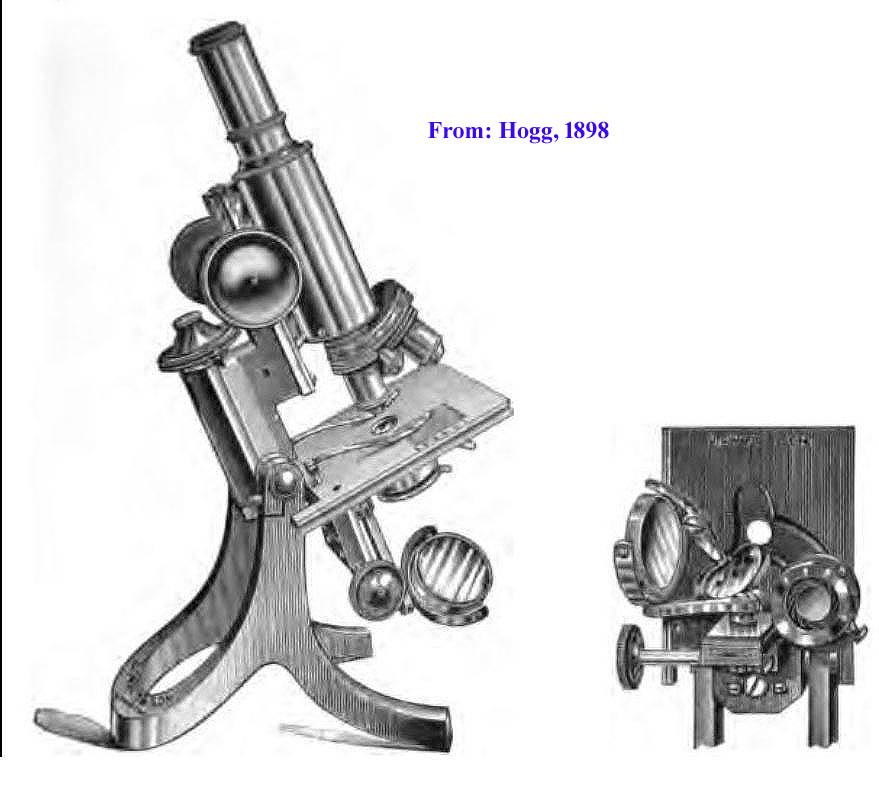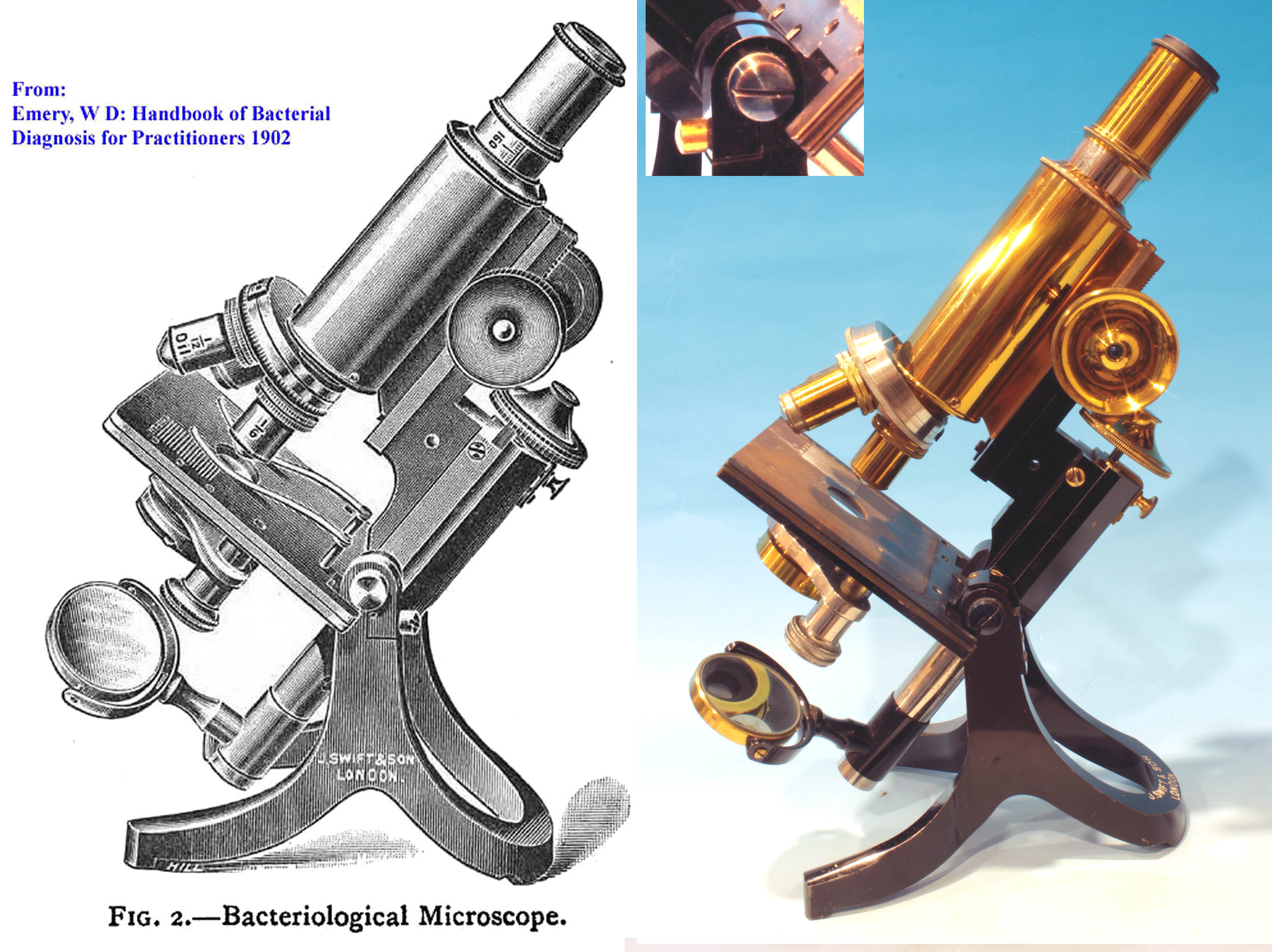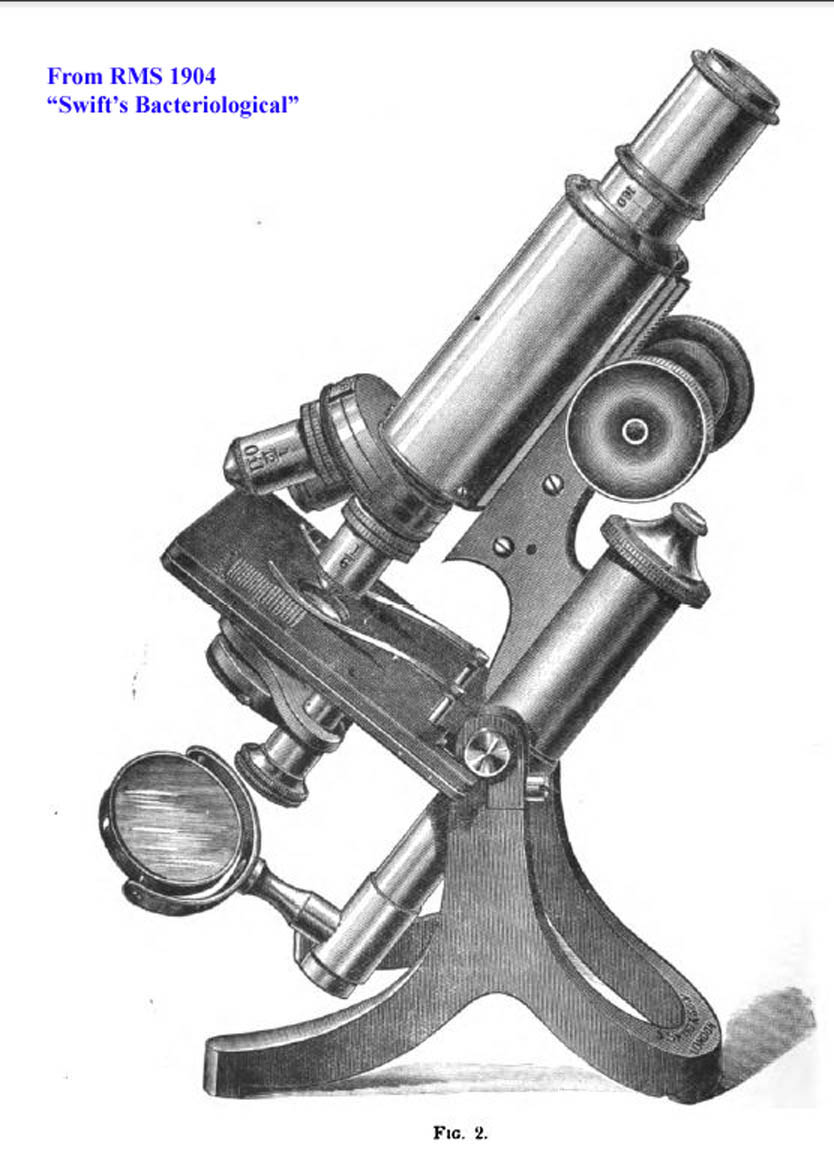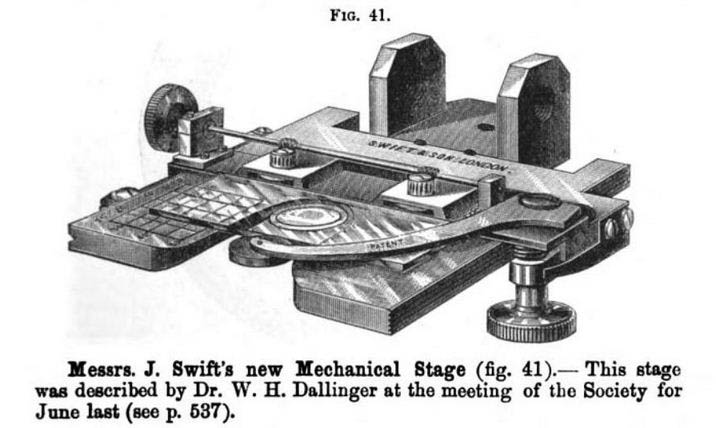MICROSCOPE-ANTIQUES.COM © 2013-25.
MAKER: JAMES SWIFT & SON
MODEL: BACTERIOLOGICAL
MICROSCOPE WITH OPTIONAL TRAVISS ROLLER STAGE
c. 1895-1897
SIGNED: J. SWIFT & SON, 81 TOTTENHAM COURT RD, LONDON
SERIAL NUMBER: none
SIGNED ON THE UPPER TUBE: BROADHURST, 63 FARINGDON RD E.C., CLARKSON & Co.
SIGNED ON THE RIGHT UPRIGHT: T. S. M. HINE
T. S. M. HINE
| DESCRIPTION | HISTORY | CONDITION |
Please Click On Any Picture for a Larger Version
DESCRIPTION:
This microscope arises on an English
or Crouch
type of foot with a U-shape in the rear forming the third toe of a tripod. It is signed by the maker on the rear of the foot, and with the owner's name in small print on the right upright. The signature of the retailer, Broadhurst & Clarkson is inscribed inside a lens-shaped insignia near the top of the drawtube. The foot and limb have an oxidized brass finish. Course focus is by diagonal rack and spiral pinion, as invented by Swift. The microscope has the Swift trademark on the back edge of the stage, and the word Patent
in the right side of the limb near hole for limb-mounted accessories.
Fine focus is by micrometer screw inside the limb which acts on the rest of the limb including the coarse focusing part. Unlike the slightly later Bacteriological model by Swift on this site, the fine focus knob has a flatter profile. The stage is covered with vulcanite (hard rubber) and has a scale in the upper right corner for registration of position on a slide, just like the 'Histological and Physiological' model and the newer Bacteriological model in this collection. There are lacquered brass capstan screws for adjusting tension on the inclination joints and lacquered brass screws for adjusting the tension of main slide for the optical tube and also for the axle of the coarse focus control.
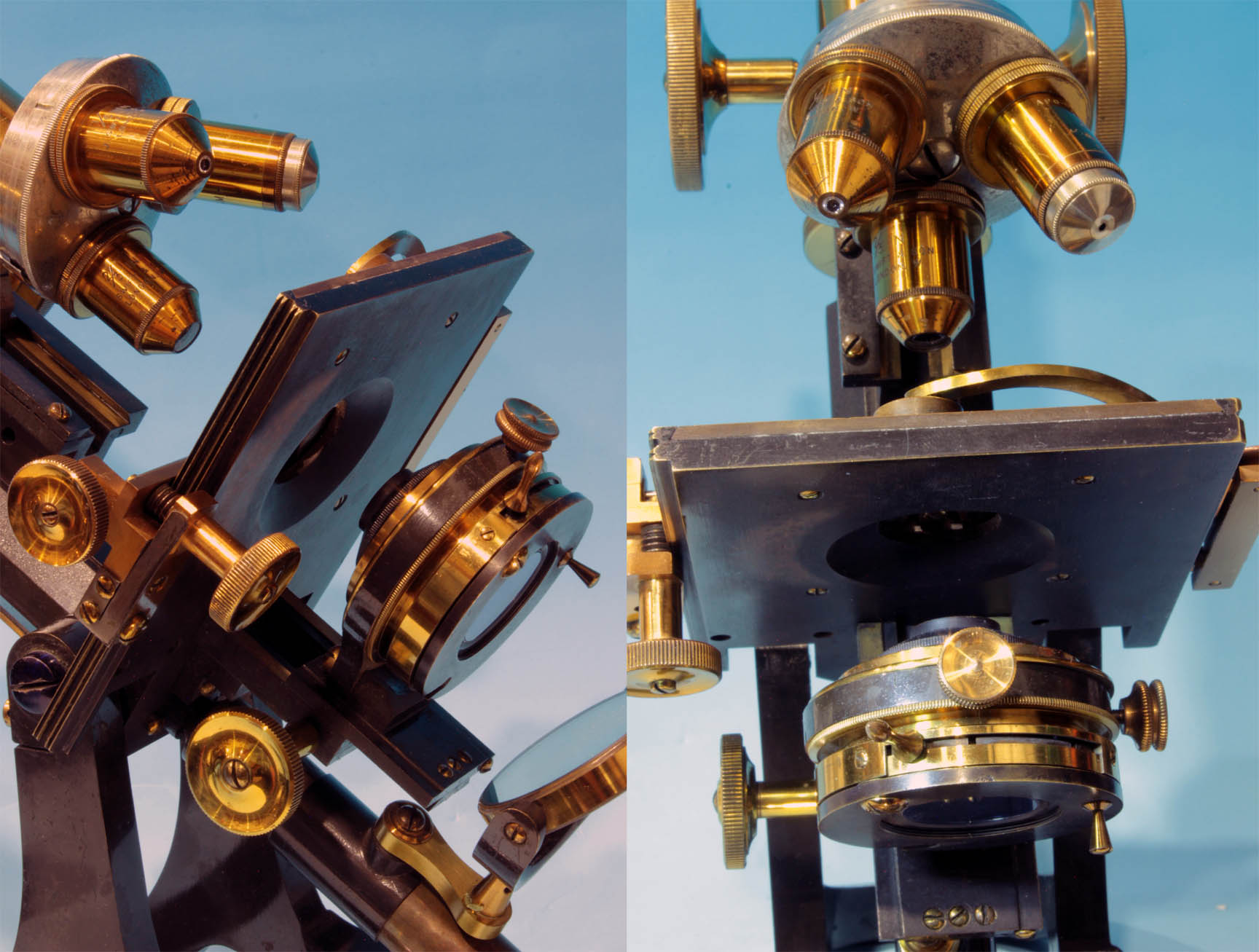 The substage is focused by diagonal rack and pinion. The substage carries an Abbe condenser with iris diaphragm, centering controls, and a swing-out light filter holder with a removable blue filter. The condenser has a removable top element to allow the condenser to function with lower power objectives.
The substage mirror is plano and concave and is on a gimbal. The mirror gimbal is attached to a bar which can rotate right or left on a blackened sleeve riding on the brass tailpiece.
The substage is focused by diagonal rack and pinion. The substage carries an Abbe condenser with iris diaphragm, centering controls, and a swing-out light filter holder with a removable blue filter. The condenser has a removable top element to allow the condenser to function with lower power objectives.
The substage mirror is plano and concave and is on a gimbal. The mirror gimbal is attached to a bar which can rotate right or left on a blackened sleeve riding on the brass tailpiece.
 There are three Swift objectives, being of 2/3, 1/6, and 1/12 inch focal lengths, the latter an oil immersion. The 1/12th also has the owner's initials
There are three Swift objectives, being of 2/3, 1/6, and 1/12 inch focal lengths, the latter an oil immersion. The 1/12th also has the owner's initials T.S.M.H.
The n.a. is 1.30 for the 1/12 inch, and 0.83 for the 1/6 objectives.
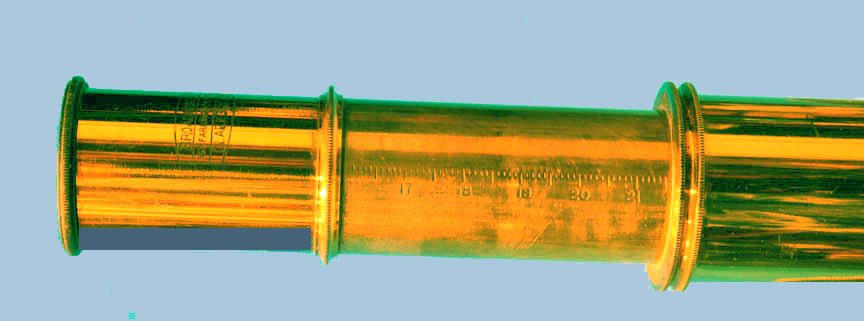
The draw tube is calibrated from 160 mm(6.3 inches) when fully closed, to 200 mm (about 7.9 inches) when maximally extended. The draw tube on this microscope is made of un-plated brass, unlike the slightly later model in this collection which has a nickel-plated draw tube. The microscope weighs a hefty 8 pounds as shown without the case.
Although this microscope closely resembles the Army Bacteriological
model, the hallmark of that slightly later model is the ability to swing the entire substage apparatus out of the optical axis, a feature not present on this model.
This microscope is equipped with a Traviss mechanical Roller Stage
. The roller stage here is signed: 358, J. SWIFT & SON LONDON PATENT 24345
. 358 is apparently the serial number, as no two roller stages have the same number. The beauty of this attachment is how quickly it can be attached or removed, without any clamps or screws. It requires, of course, the stage already be pre-machined with the grooves, and to my knowledge, only Swift grooved the sides of their stages. Attaching the stage is simple; the two fixed wheels on the left side are placed in their track, and the user holds the sprung box on the right away from the stage, aligns the flanges over the tracks on the right side and releases the tension.
This device works well with some caveats. The stage must be smooth-polished with a thin coat of wax. Secondly the contacting edges rubber wheels must be free of any grease or they will slip and not move the slide. Third, the arm holding the top third wheel must be adjusted (by gently bending parts of it as needed), to run flat on the surface but without any downward pressure. I found museum wax satisfactory for the stage. The tracks on the sides of the stage and the rollers that contact it must also be free of grease. I found using methanol to clean all the contacting rubber edges as well as the stage sides and the contacting parts on the stage sides resulted in satisfactory results; one must be careful not to get the methanol on the lacquer as it will remove it!.
 The substage is focused by diagonal rack and pinion. The substage carries an Abbe condenser with iris diaphragm, centering controls, and a swing-out light filter holder with a removable blue filter. The condenser has a removable top element to allow the condenser to function with lower power objectives.
The substage mirror is plano and concave and is on a gimbal. The mirror gimbal is attached to a bar which can rotate right or left on a blackened sleeve riding on the brass tailpiece.
The substage is focused by diagonal rack and pinion. The substage carries an Abbe condenser with iris diaphragm, centering controls, and a swing-out light filter holder with a removable blue filter. The condenser has a removable top element to allow the condenser to function with lower power objectives.
The substage mirror is plano and concave and is on a gimbal. The mirror gimbal is attached to a bar which can rotate right or left on a blackened sleeve riding on the brass tailpiece.
 There are three Swift objectives, being of 2/3, 1/6, and 1/12 inch focal lengths, the latter an oil immersion. The 1/12th also has the owner's initials
There are three Swift objectives, being of 2/3, 1/6, and 1/12 inch focal lengths, the latter an oil immersion. The 1/12th also has the owner's initials T.S.M.H.The n.a. is 1.30 for the 1/12 inch, and 0.83 for the 1/6 objectives.

The draw tube is calibrated from 160 mm(6.3 inches) when fully closed, to 200 mm (about 7.9 inches) when maximally extended. The draw tube on this microscope is made of un-plated brass, unlike the slightly later model in this collection which has a nickel-plated draw tube. The microscope weighs a hefty 8 pounds as shown without the case.
Army Bacteriologicalmodel, the hallmark of that slightly later model is the ability to swing the entire substage apparatus out of the optical axis, a feature not present on this model.
Roller Stage. The roller stage here is signed:
358, J. SWIFT & SON LONDON PATENT 24345. 358 is apparently the serial number, as no two roller stages have the same number. The beauty of this attachment is how quickly it can be attached or removed, without any clamps or screws. It requires, of course, the stage already be pre-machined with the grooves, and to my knowledge, only Swift grooved the sides of their stages. Attaching the stage is simple; the two fixed wheels on the left side are placed in their track, and the user holds the sprung box on the right away from the stage, aligns the flanges over the tracks on the right side and releases the tension.
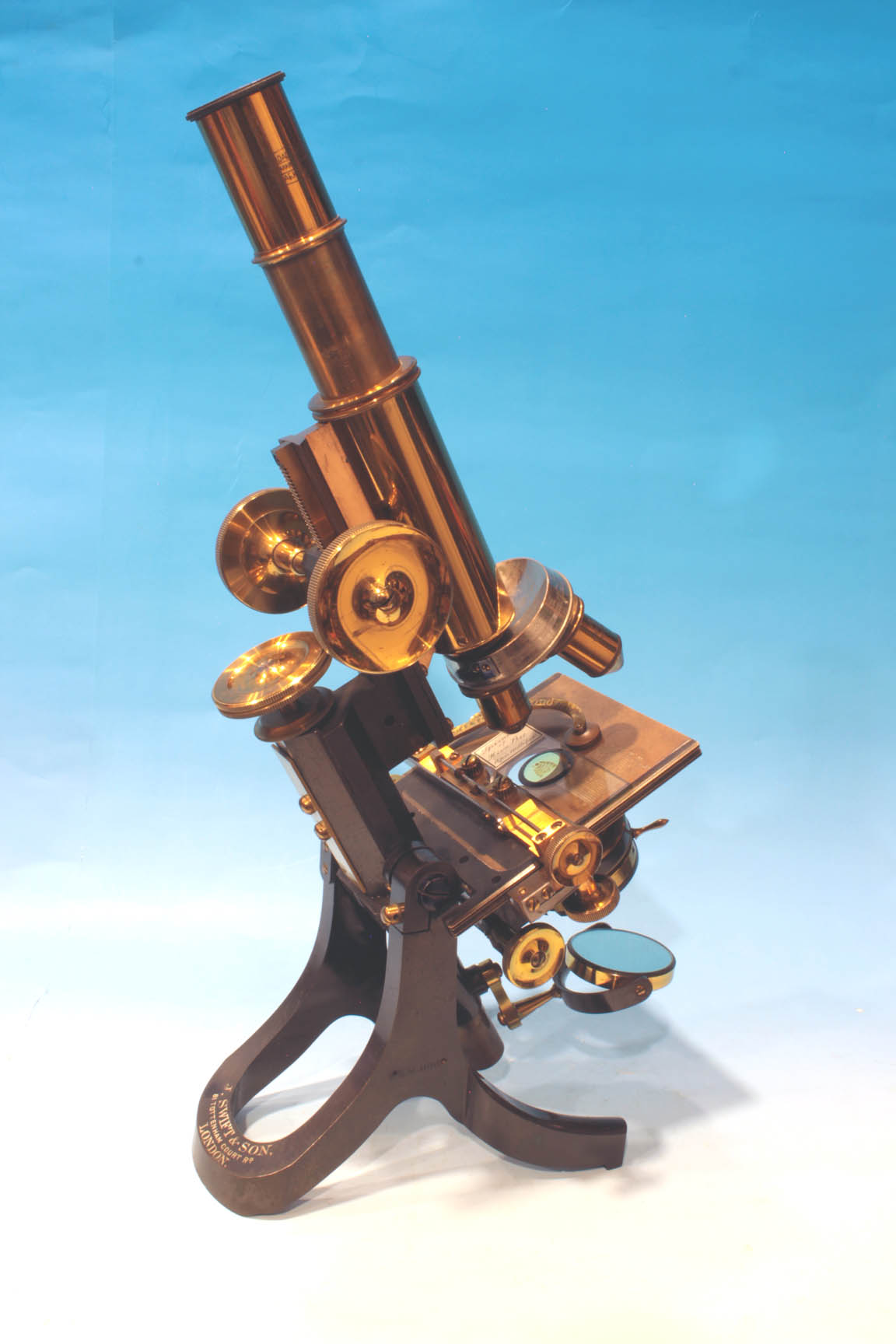
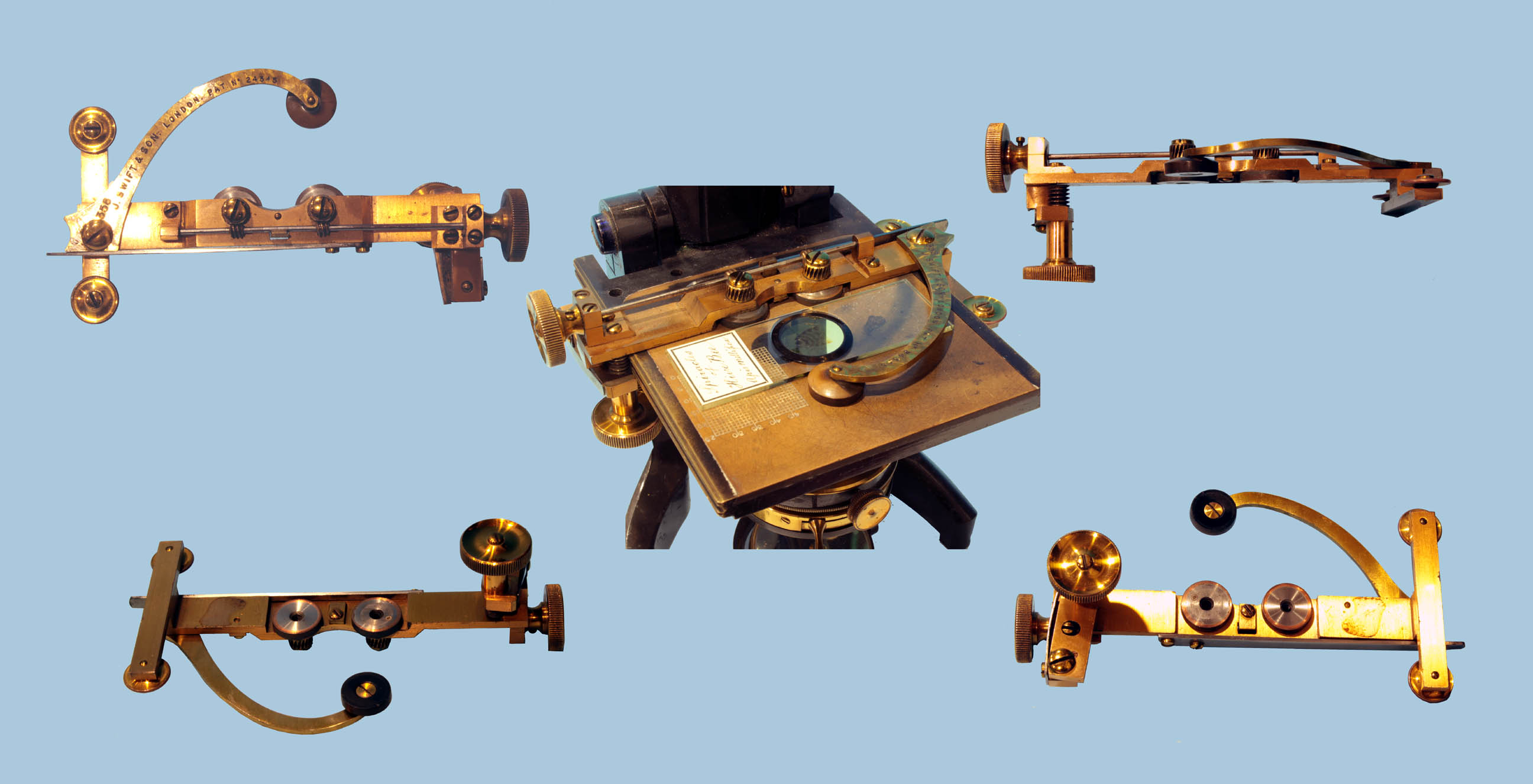
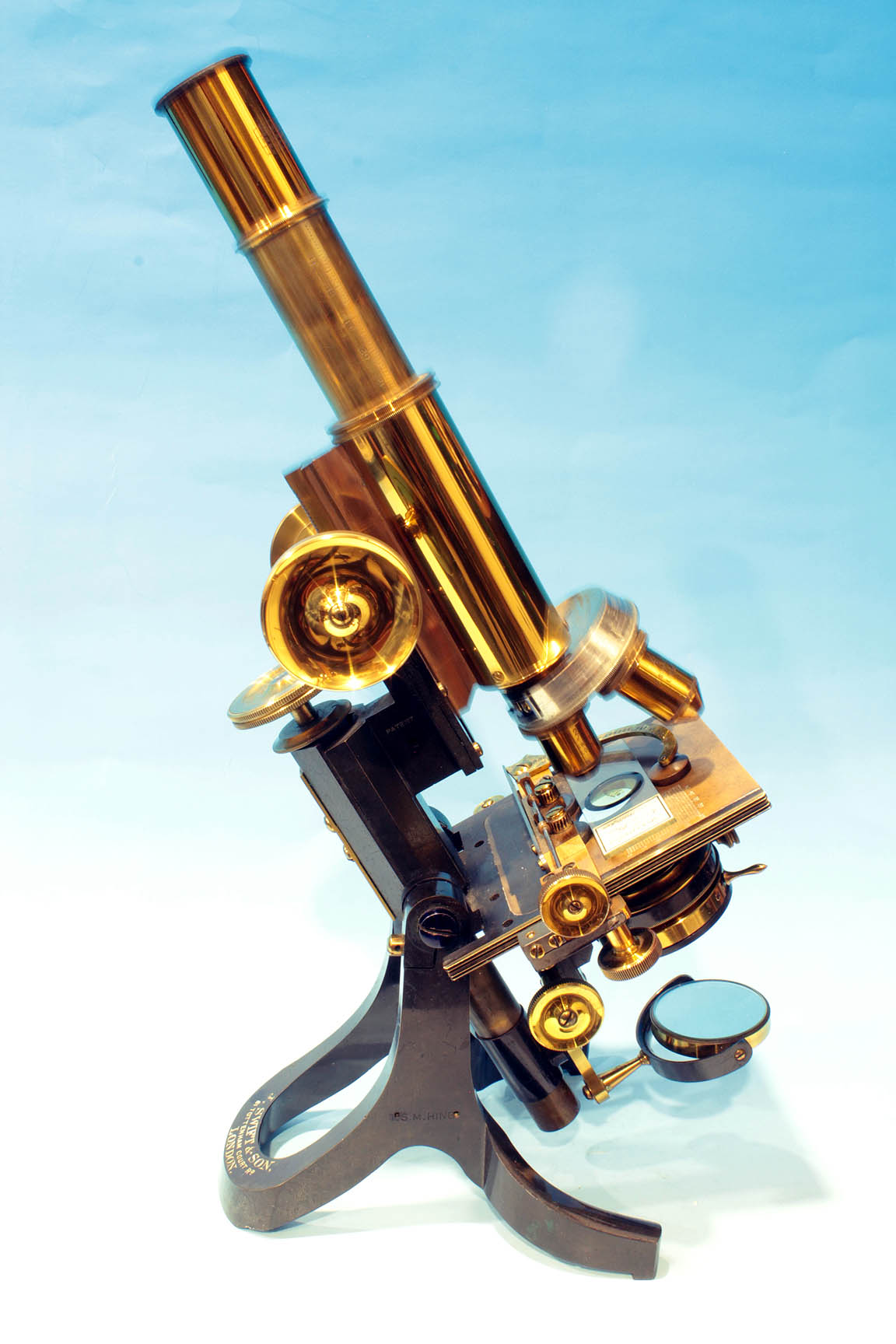
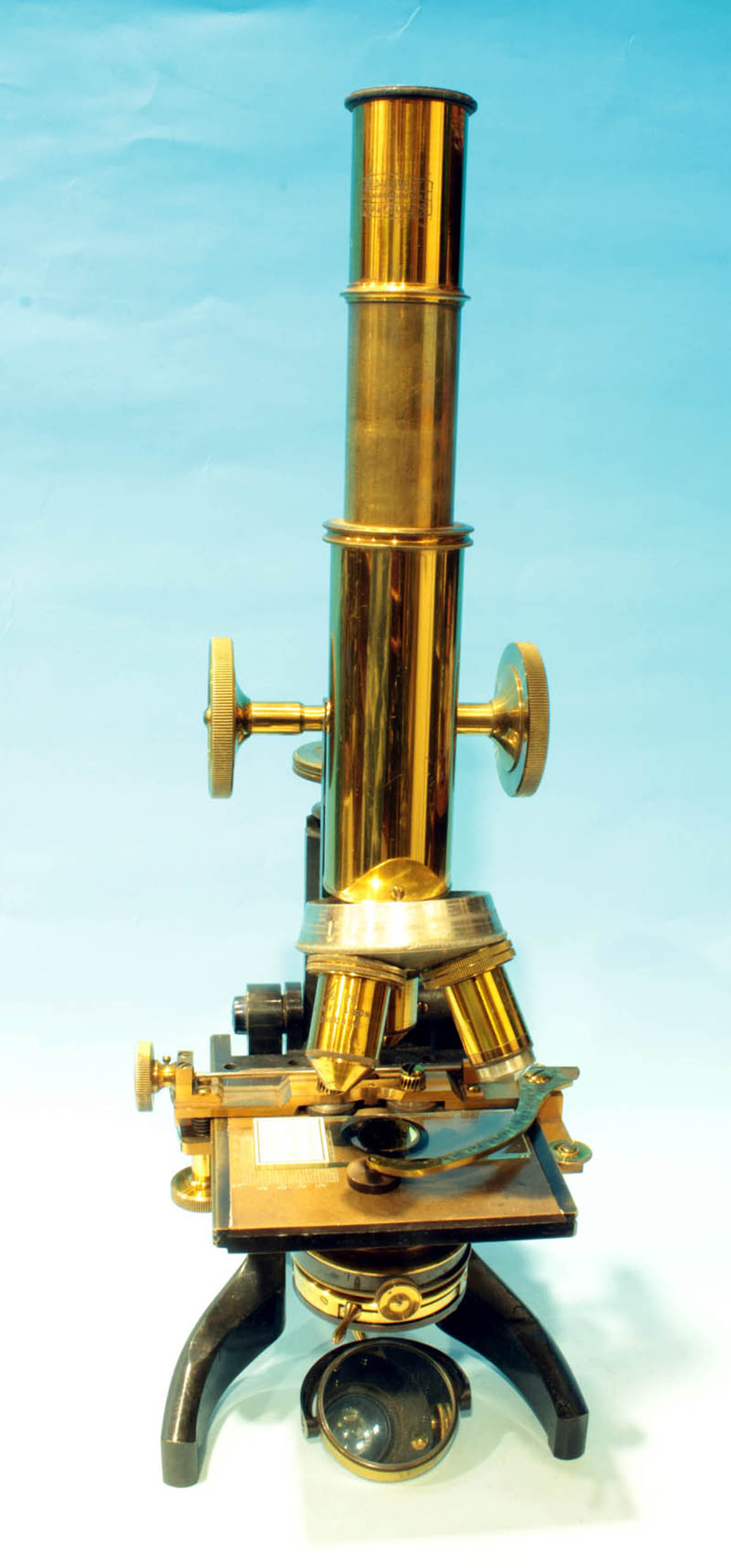
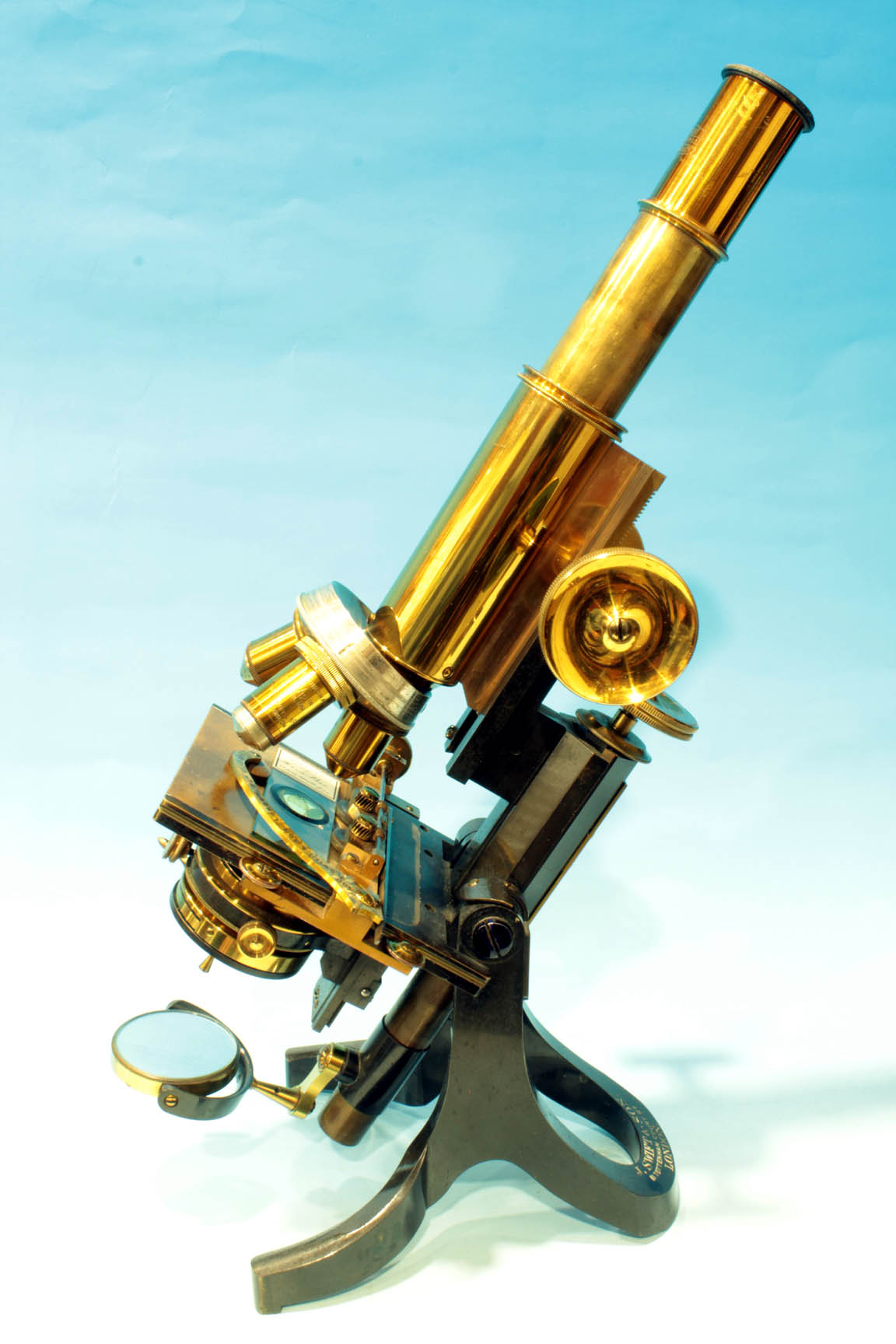
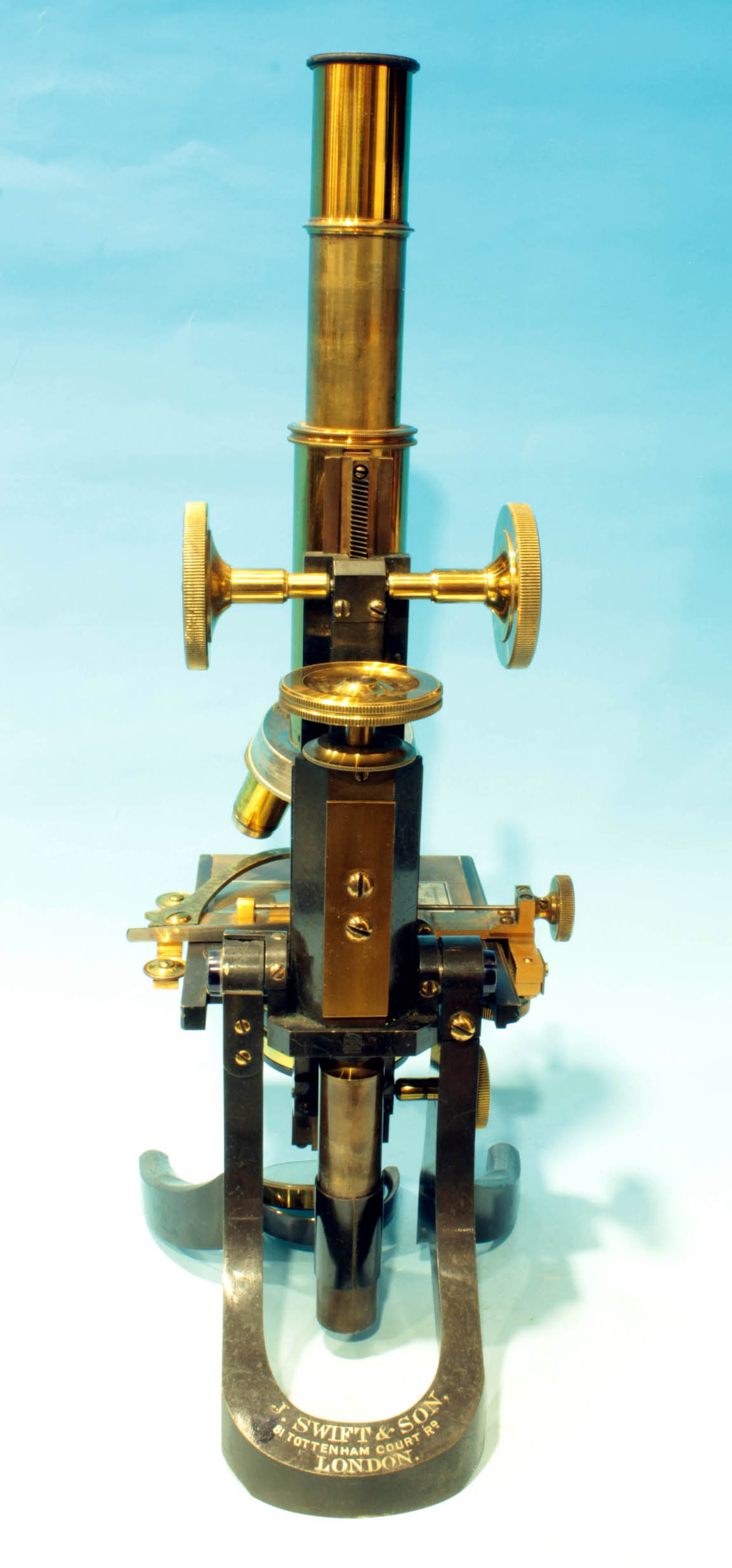
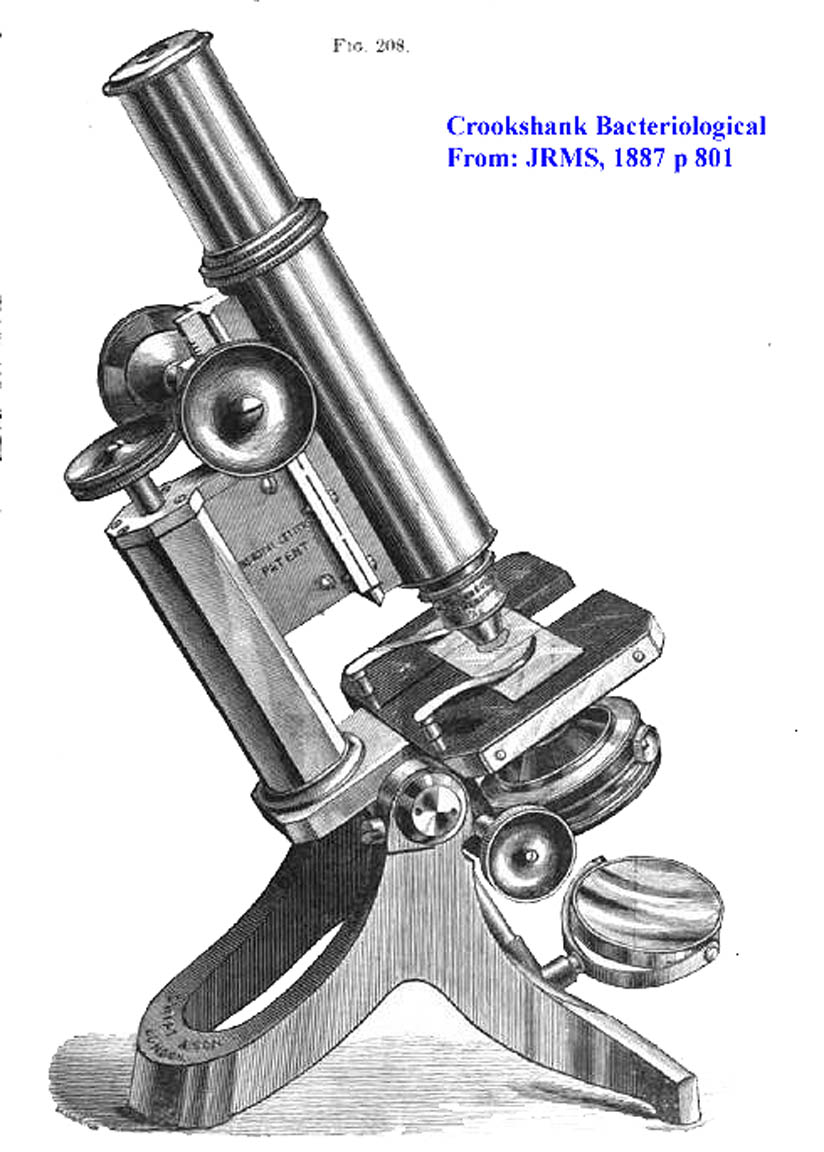
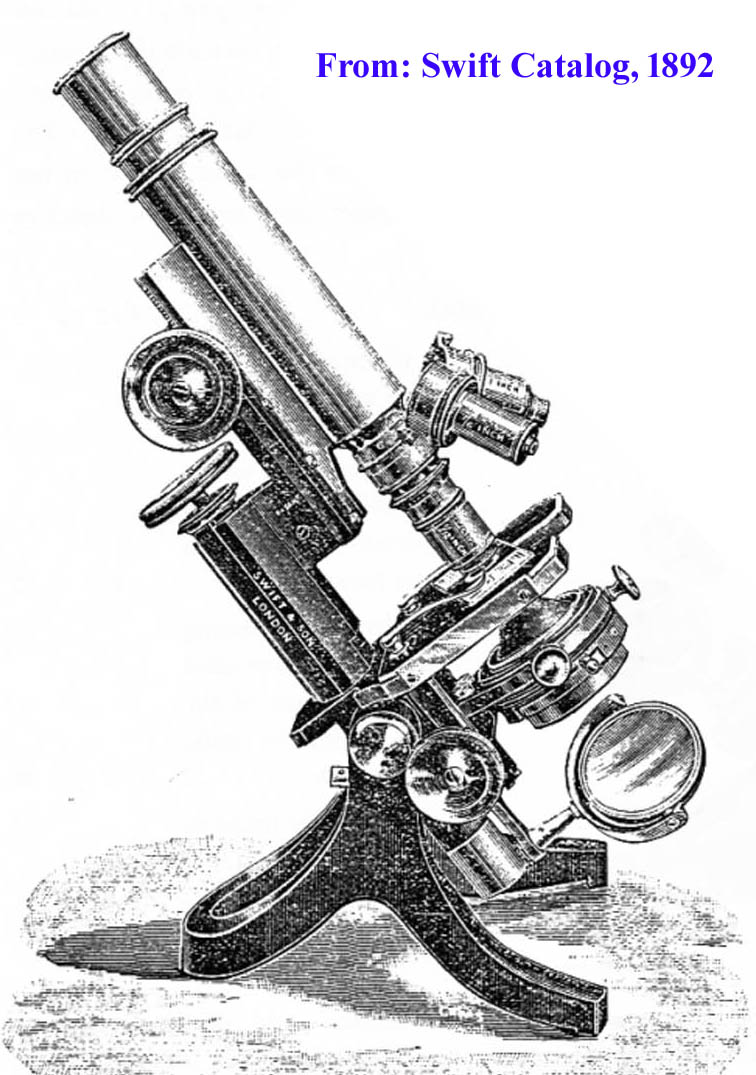
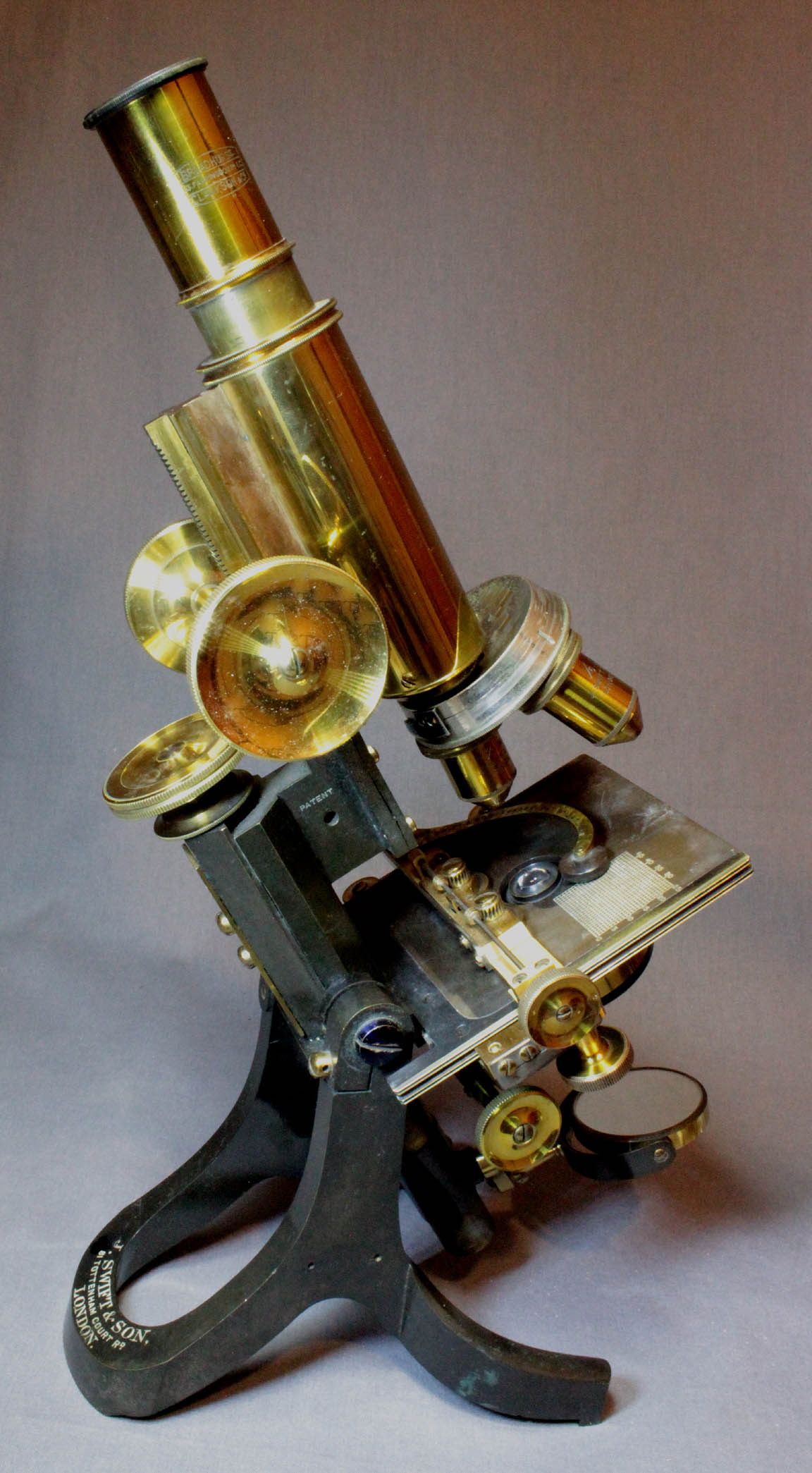 Once the Traviss Roller stage was invented in 1894, the Crookshank model had grooves on the side of the stage to accommodate it. The example shown to the left must date to around 1895 as the Roller stage controls were originally on opposite sides of the stage, and this example has both the controls on the same side, a change that took place around 1895. Like the 1892 model, the stage is no longer glass-covered the surface now being covered with hard rubber to maintain warm temperatures, and it is also no longer U-shaped. Note the same flatter design of the fine focus as the previous model. Note that this model has an articulated mirror support whereas the later model had the mirror attached via a straight piece attached directly to the collar on the tailpiece. This model has a slightly taller foot with the axis of inclination higher than the prior model. The axis of inclination on this example is 5 inches high, as opposed to 4 inches on the prior model, (and also subsequent models, with the exception of the Army model described in the next paragraph). To see a height comparison of this model with the 1904 model see the
Once the Traviss Roller stage was invented in 1894, the Crookshank model had grooves on the side of the stage to accommodate it. The example shown to the left must date to around 1895 as the Roller stage controls were originally on opposite sides of the stage, and this example has both the controls on the same side, a change that took place around 1895. Like the 1892 model, the stage is no longer glass-covered the surface now being covered with hard rubber to maintain warm temperatures, and it is also no longer U-shaped. Note the same flatter design of the fine focus as the previous model. Note that this model has an articulated mirror support whereas the later model had the mirror attached via a straight piece attached directly to the collar on the tailpiece. This model has a slightly taller foot with the axis of inclination higher than the prior model. The axis of inclination on this example is 5 inches high, as opposed to 4 inches on the prior model, (and also subsequent models, with the exception of the Army model described in the next paragraph). To see a height comparison of this model with the 1904 model see the 